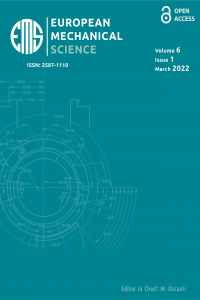Abstract
Supporting Institution
Ege üniversitesi Makine Mühendisiliği Bölümü
References
- Renewable energy directive. (2014, July 16). European Commission: https://ec.europa.eu/energy/topics/renewable-energy/renewable-energy-directive/overview_en adresinden alındı.
- Ioan Sarbu, C. S. (2016, August). Solar Assisted Heat Pump Systems. Renewable Energy, 79-129. doi:10.1016/B978-0-12-811662-3.00009-8
- Martin Kegel, J. T. (2012, December). Assessment of a solar assisted air source and a solar assisted water source heat pump system in a Canadian household. Energy Procedia, 30, 654-663. doi:10.1016/j.egypro.2012.11.074
- John A. Duffie, W. A. (2013). Solar Engineering of Thermal Processes : The Solar Constant (4nd ed. b.). New Jersey, Haboken, United States of America: John Wiley & Sons.
- Warren M. Rohsenow, J. R. (1998). Handbook of Heat Transfer : Chapter 7.Radiation (Cilt 3). New-York: McGraw-Hill.
- IAPWS R6-95 Revised Release on the IAPWS Formulation 1995 for the Thermodynamic Properties of Ordinary Water Substance for General and Scientific Use September 2018. (2018, 12 21). İAPWS.ORG. http://www.iapws.org/relguide/IAPWS-95.html adresinden alındı.
- A. A. Ammar, K. S. (2019). Performance study on photovoltaic/thermal solar-assisted heat pump. Journal of Thermal Analysis and Calorimetry, 136(1), 79-87. doi:10.1007/s10973-018-7741-6
- Peter Omojaro, C. B. (2013). Direct expansion solar assisted heat pumps. Renewable and Sustainable Energy Reviews, 22, 33-45. doi:http://dx.doi.org/10.1016/j.rser.2013.01.029
- Mahmut Sami Buker, S. B. (2016). Solar assisted heat pump systems for low temperature water heating. RenewableandSustainableEnergyReviews, 55(2016), 399–413. http://dx.doi.org/10.1016/j.rser.2015.10.157 adresinden alındı
Abstract
In this study, the Solar Energy Assisted Heat Pump (SAHP) system is modeled by creating different processes with the help of various models created in the JAVA program. The SAHP model was created in order to obtain hot water by utilizing solar energy. The inlet water temperature in the system was taken as 10 °C in December and 20.5 °C in June and the SAHP model was analyzed by numerical method. In the evaporator model, considering the coordinates of the city of Izmir, various graphs were created by calculating the different spectral solar energy values falling on 1 m2 evaporator plate on certain days of 2019. In the graphics, the highest energy density on 1 m2 evaporator plate for İzmir province was 852.095 W/m2 on 21 June at 12:00, and the lowest energy density was 455.143 W/m2 on 21 December at 12:00. In the SAHP system, the evaporator plate area was determined as 2.40 m2 and the compressor power was 0.56kW, and a condenser model was created. The required condenser surface areas were found by calculating the thermal energies given by the condenser for different dates in the system. In the modeling of the heat pump, the Coefficient of Performance (COP) of the SAHP system for R134a and R404A was obtained by taking the date of June 21, 12:00, when the spectral energy is most intense, as a reference.
Keywords
Solar Energy Solar Powered Heat Pump JAVA Modeling Heat Pump Energy Efficiency Performance Analysis Sustainable Energy
References
- Renewable energy directive. (2014, July 16). European Commission: https://ec.europa.eu/energy/topics/renewable-energy/renewable-energy-directive/overview_en adresinden alındı.
- Ioan Sarbu, C. S. (2016, August). Solar Assisted Heat Pump Systems. Renewable Energy, 79-129. doi:10.1016/B978-0-12-811662-3.00009-8
- Martin Kegel, J. T. (2012, December). Assessment of a solar assisted air source and a solar assisted water source heat pump system in a Canadian household. Energy Procedia, 30, 654-663. doi:10.1016/j.egypro.2012.11.074
- John A. Duffie, W. A. (2013). Solar Engineering of Thermal Processes : The Solar Constant (4nd ed. b.). New Jersey, Haboken, United States of America: John Wiley & Sons.
- Warren M. Rohsenow, J. R. (1998). Handbook of Heat Transfer : Chapter 7.Radiation (Cilt 3). New-York: McGraw-Hill.
- IAPWS R6-95 Revised Release on the IAPWS Formulation 1995 for the Thermodynamic Properties of Ordinary Water Substance for General and Scientific Use September 2018. (2018, 12 21). İAPWS.ORG. http://www.iapws.org/relguide/IAPWS-95.html adresinden alındı.
- A. A. Ammar, K. S. (2019). Performance study on photovoltaic/thermal solar-assisted heat pump. Journal of Thermal Analysis and Calorimetry, 136(1), 79-87. doi:10.1007/s10973-018-7741-6
- Peter Omojaro, C. B. (2013). Direct expansion solar assisted heat pumps. Renewable and Sustainable Energy Reviews, 22, 33-45. doi:http://dx.doi.org/10.1016/j.rser.2013.01.029
- Mahmut Sami Buker, S. B. (2016). Solar assisted heat pump systems for low temperature water heating. RenewableandSustainableEnergyReviews, 55(2016), 399–413. http://dx.doi.org/10.1016/j.rser.2015.10.157 adresinden alındı
Details
| Primary Language | English |
|---|---|
| Subjects | Mechanical Engineering |
| Journal Section | Research Article |
| Authors | |
| Publication Date | March 20, 2022 |
| Acceptance Date | August 11, 2021 |
| Published in Issue | Year 2022 Volume: 6 Issue: 1 |


